Understanding Scales on Guitar: A Beginner’s Guide
Category: Music Theory
Unlock the Secrets of Guitar Scales with Ease
Are you a beginner guitarist eager to grasp the fundamentals of scales without getting overwhelmed? Maybe you've tried to learn scales before but found the theory confusing or the finger patterns hard to memorize. This guide is crafted just for you—whether you've just picked up your guitar or are struggling to connect music theory to practical playing. Understanding scales on guitar is a crucial step in enhancing your improvisation, composition, and overall musicianship. Most tutorials flood you with jargon or skip the basics, making the journey frustrating.
Here, we break down scales into clear, bite-sized lessons paired with simple exercises, focusing on practical application. We don’t just cover what scales are but show you how to find them on your fretboard and use them in real musical contexts. Plus, we incorporate comparisons to piano to deepen your musical understanding. By the end, you'll feel confident navigating scales, unlocking new musical possibilities with your guitar, and even seeing the connections to piano scales. So, let's embark on this beginner-friendly journey together and transform your guitar playing with the power of scales!
- Unlock the Secrets of Guitar Scales with Ease
- What Are Musical Scales? Basics Explained for Guitarists and Pianists
- Understanding the Major Scale on Guitar: Step-by-Step Guide
- Exploring the Minor Scales: Natural, Harmonic, and Melodic Minor Scale Shapes and Their Uses on Guitar
- The Pentatonic Scales: Blueprints for Blues and Rock Guitar, with Easy-to-Learn Patterns
- How to Visualize Scales on the Fretboard: Tips and Tricks to Map Out Scales Effectively for Practice and Improvisation
- The Connection Between Guitar and Piano Scales: How Patterns Translate Across Instruments for Better Theory Comprehension
- Common Scale Modes and Their Emotional Colors: Introduction to Dorian, Phrygian, and Mixolydian on Guitar
- Practical Exercises to Master Scales: Step-by-Step Practice Routines for Guitarists
- Using Scales to Improvise and Compose: Applying Your Scale Knowledge in Songwriting, Soloing, and Jamming
- Tips for Memorizing and Internalizing Scales: Effective Strategies for Lasting Musical Growth
What Are Musical Scales? Basics Explained for Guitarists and Pianists
At its core, a musical scale is simply a sequence of notes arranged in ascending or descending order, forming the foundation of melodies, harmonies, and improvisation. For both guitarists and pianists, understanding scales means unlocking the language of music—allowing you to recognize patterns, create musical phrases, and navigate your instrument with confidence.
The Building Blocks: Scale Degrees
Every scale is made up of distinct steps called scale degrees, each playing a specific role in the sound and mood of the scale. For example, in the popular major scale, there are seven scale degrees, typically numbered 1 through 7:
- Root (1) – The home note or tonal center
- Second (2)
- Third (3) – Major or minor quality often determined here
- Fourth (4)
- Fifth (5) – Provides harmonic stability
- Sixth (6)
- Seventh (7) – Leads back to root, creating tension and resolution
These scale degrees are essential because they shape the emotional character and harmonic possibilities of a scale. For instance, altering the third note changes a major scale into a minor scale, significantly affecting the mood.
Why Do Scales Matter in Music Theory?
Scales serve as the roadmap for melodies and solos, helping musicians know which notes fit well together. For guitarists and pianists alike:
- Improvisation: Scales guide your note choices when creating solos or improvising over chord progressions.
- Composition: Knowing different scales allows you to craft melodies and harmonies that suit the style or emotion you want to express.
- Sight-reading & Ear Training: Recognizing scale patterns improves your ability to read music and hear musical relationships.
- Instrument Navigation: Scales reveal patterns on the fretboard and keyboard, making it easier to find notes quickly and intuitively.
By mastering the concept of scales and their degrees, you build a strong theoretical foundation that directly improves your practical playing—whether you’re strumming chords on guitar or playing melodies on piano. In the next sections, we’ll explore the most common scales for guitar and piano and show you simple methods to play and internalize them.
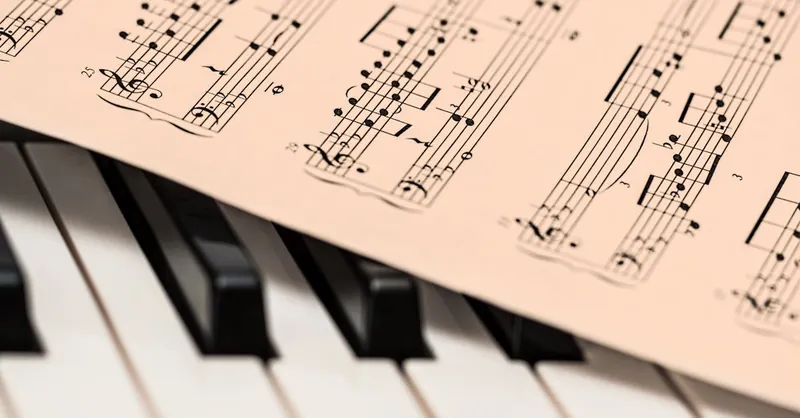
Image courtesy of Pixabay
Understanding the Major Scale on Guitar: Step-by-Step Guide
The major scale is the foundation of Western music theory and arguably the most important scale to learn on guitar and piano alike. Its bright, happy sound forms the basis of countless songs, melodies, and harmonies. On guitar, mastering the major scale pattern unlocks the fretboard and sets you up for exploring other scales, modes, and musical styles with confidence.
The Major Scale Formula: Whole and Half Steps
Before diving into finger placement, it's crucial to understand the major scale’s step pattern. The scale consists of seven notes following this sequence of intervals:
- Whole step (W)
- Whole step (W)
- Half step (H)
- Whole step (W)
- Whole step (W)
- Whole step (W)
- Half step (H)
Translated to semitones on the guitar fretboard, this means moving 2 frets for a whole step and 1 fret for a half step as you play the scale ascending.
Playing the Major Scale on Guitar: Basic Pattern and Fingering
Let’s walk through the C major scale starting on the 8th fret of the low E string (6th string). This position covers one common shape of the major scale and is beginner-friendly:
| String | Fret Numbers (Notes in C Major Scale) | Suggested Fingers |
|---|---|---|
| 6 (E) | 8 (C), 10 (D) | 1 (index), 3 (ring) |
| 5 (A) | 7 (E), 8 (F), 10 (G) | 1 (index), 2 (middle), 4 (pinky) |
| 4 (D) | 7 (A), 9 (B) | 1 (index), 3 (ring) |
| 3 (G) | 7 (D), 9 (E) | 1 (index), 3 (ring) |
| 2 (B) | 8 (F), 10 (G) | 1 (index), 3 (ring) |
| 1 (E) | 8 (C), 10 (D) | 1 (index), 3 (ring) |
Step-by-Step Playing Tips
- Start Slow: Begin by playing each note in the scale one at a time, using the suggested fingerings to build muscle memory.
- Follow the Pattern: Notice how the whole and half steps create the familiar sound of the major scale as you ascend and descend.
- Use Alternate Picking: Combining down and up strokes with your pick will help play the scale smoothly and evenly.
- Visualize the Scale Degrees: As you play, mentally label the root (C in this case) and other scale degrees to connect theory and fretboard patterns.
Why Learn This Pattern?
This major scale position is a gateway pattern that helps you:
- Recognize how the major scale fits across strings and frets
- Understand finger positioning that supports fluid playing
- Apply the same interval concept to other keys by shifting the pattern up or down the fretboard
Once comfortable, try moving this pattern up two frets to play a D major scale or down three frets to get an A major scale—this is what makes the major scale such a powerful tool for guitarists.
Mastering this core major scale shape on your guitar fretboard empowers you to improvise, compose, and jam more creatively, and it sets a solid base for exploring the piano keyboard’s parallel layouts too.
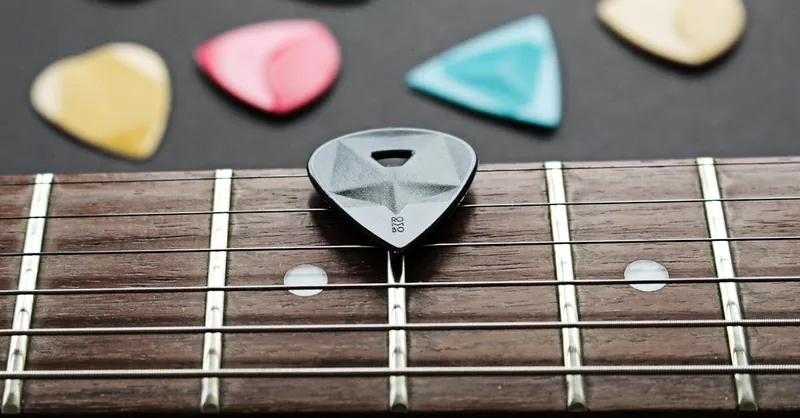
Image courtesy of ROMBO
Exploring the Minor Scales: Natural, Harmonic, and Melodic Minor Scale Shapes and Their Uses on Guitar
After mastering the major scale, the next essential step in your guitar and music theory journey is understanding the minor scales—the cornerstone of many genres, from blues and rock to classical and jazz. The three primary minor scales—Natural Minor, Harmonic Minor, and Melodic Minor—each bring a unique flavor and mood, expanding your melodic and harmonic palette significantly.
The Natural Minor Scale: The Foundation of Minor Tonality
The Natural Minor scale (also called the Aeolian mode) is constructed by starting on the sixth degree of the major scale and follows this interval pattern:
- Whole step (W)
- Half step (H)
- Whole step (W)
- Whole step (W)
- Half step (H)
- Whole step (W)
- Whole step (W)
This scale creates a melancholy, introspective sound and is often the first minor scale beginner guitarists learn. On guitar, the natural minor scale shares many fretboard shapes with the major scale, just shifted in position, making it accessible once you know your major scale patterns.
Harmonic Minor Scale: Adding Exotic Color and Tension
The Harmonic Minor scale is a variation of the natural minor scale with a raised seventh degree. This alteration creates an exotic, Middle Eastern or classical feel and introduces a distinctive leading tone that adds tension and resolution, perfect for soloing and composition in minor keys.
- Interval pattern: W, H, W, W, H, 1.5 steps (augmented second), H
This raised seventh makes the Harmonic Minor particularly useful for:
- Creating dramatic, classical-style melodies
- Enhancing tension over minor chord progressions, especially V-i cadences
- Developing solos with a distinct, unexpected character on guitar
Melodic Minor Scale: The Jazz and Fusion Favorite
The Melodic Minor scale takes a sophisticated approach by raising both the sixth and seventh degrees ascending, then typically reverting to the natural minor descending, though on guitar players often use the ascending form both ways for improvisation. This scale strikes a balance between the natural and harmonic minor sounds, providing smooth, jazz-inflected tones.
- Ascending interval pattern: W, H, W, W, W, W, H
Use the melodic minor scale on guitar to:
- Improvise over minor major seventh chords
- Add complexity and jazz colors to solos
- Explore fluid, lyrical phrasing beyond the typical minor sound
Applying Minor Scale Shapes on Guitar
Each minor scale can be mapped out across the fretboard with specific scale shapes and fingerings similar to major scales but altered to fit their unique intervals. For beginners:
- Start with the Natural Minor scale shape, such as the A natural minor scale starting at the 5th fret of the low E string.
- Modify the shape for Harmonic Minor by sharpening the seventh note—a slight positional adjustment that introduces new fretboard notes.
- Practice the Melodic Minor form by incorporating the raised sixth and seventh degrees, focusing on smooth transitions to internalize the scale’s character.
Developing fluency in these minor scales not only enhances your soloing vocabulary but also deepens your understanding of tonal moods and chord progressions on guitar and piano. Embracing these scales opens doors to genres like classical, flamenco, jazz, and metal, where minor scales reign supreme.
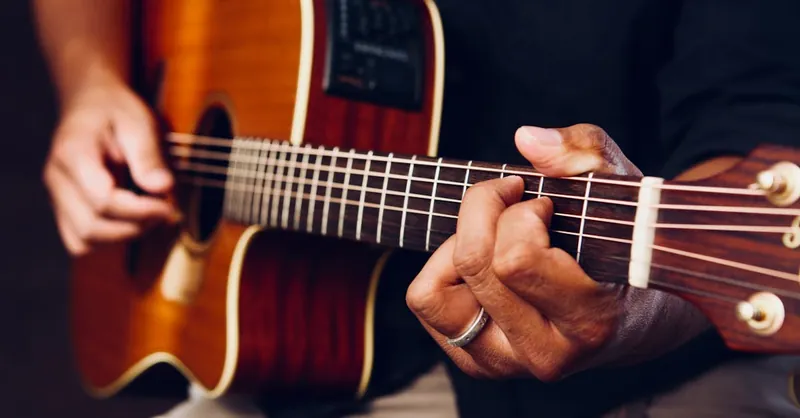
Image courtesy of Brent Keane
The Pentatonic Scales: Blueprints for Blues and Rock Guitar, with Easy-to-Learn Patterns
One of the most essential and beginner-friendly scales for guitarists is the pentatonic scale—a five-note scale that forms the backbone of countless blues, rock, and popular music solos. Unlike the seven-note major and minor scales, pentatonic scales simplify note choices, making them ideal for improvisation and songwriting without the risk of hitting ‘wrong’ notes. This scale’s straightforward patterns and versatile sound make it a go-to tool for guitar players eager to express emotion and groove instantly.
What Makes Pentatonic Scales So Popular for Guitar?
- Simplicity and Accessibility: The pentatonic scale reduces complexity, making it easier to memorize and apply on the fretboard.
- Bluesy and Rock Tone: It contains intervals that create the characteristic "bluesy" sound, especially when paired with the blues scale variant.
- Versatility: Works over many chord progressions and musical styles, from classic rock riffs to soulful blues solos.
- Fretboard Patterns: Pentatonic shapes are movable across the guitar neck, offering a universal blueprint that supports playing in any key.
The Two Main Pentatonic Scales for Guitarists
- Major Pentatonic Scale
- Consists of the 1st, 2nd, 3rd, 5th, and 6th degrees of the major scale.
- Example Pattern in C Major Pentatonic: C, D, E, G, A
-
Sound: Bright, happy, and melodic—great for country, pop, and light rock.
-
Minor Pentatonic Scale
- Formed by the 1st, flat 3rd, 4th, 5th, and flat 7th degrees of the natural minor scale.
- Example Pattern in A Minor Pentatonic: A, C, D, E, G
- Sound: Raw, soulful, and gritty—perfect for blues, rock, and hard-hitting solos.
Easy-to-Learn Pentatonic Patterns for Guitar
Pentatonic scales are commonly learned through box patterns, which group notes into compact shapes that are simple to internalize. For example, the A minor pentatonic box pattern (starting on the 5th fret of the low E string) covers all five notes and repeats across strings:
| String | Frets (A Minor Pentatonic Notes) | Fingers (Recommended) |
|---|---|---|
| 6 (E) | 5 (A), 8 (C) | 1 (index), 4 (pinky) |
| 5 (A) | 5 (D), 7 (E) | 1 (index), 3 (ring) |
| 4 (D) | 5 (G), 7 (A) | 1 (index), 3 (ring) |
| 3 (G) | 5 (C), 7 (D) | 1 (index), 3 (ring) |
| 2 (B) | 5 (E), 8 (G) | 1 (index), 4 (pinky) |
| 1 (E) | 5 (A), 8 (C) | 1 (index), 4 (pinky) |
Tips for Practicing Pentatonic Scales on Guitar
- Start Slowly: Play the box pattern ascending and descending with alternate picking to develop finger independence.
- Focus on Root Notes: Identify and emphasize the root (tonic) notes within the pattern for a strong tonal center.
- Add Bends and Slides: Incorporate expressive techniques like string bends, slides, and hammer-ons to capture the bluesy feel.
- Jam Over Backing Tracks: Practice improvising over simple blues or rock backing tracks in the same key to internalize how the pentatonic scale fits musically.
Mastering the pentatonic scales not only strengthens your soloing ability but also enhances your understanding of fretboard geography. Moreover, recognizing the pentatonic scale patterns on piano further strengthens your overall music theory knowledge, as the five-note structure translates well across instruments. Whether you’re playing blues licks on guitar or crafting melodic hooks on piano, the pentatonic scale offers a powerful, accessible toolset for creative expression.
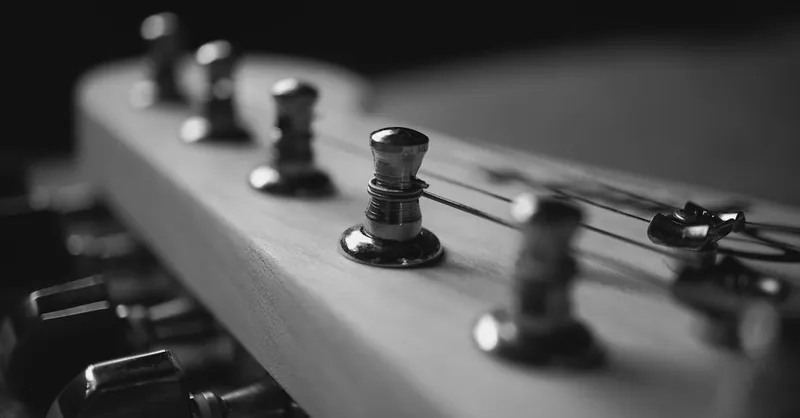
Image courtesy of Alejandro Maroto
How to Visualize Scales on the Fretboard: Tips and Tricks to Map Out Scales Effectively for Practice and Improvisation
Visualizing scales on the guitar fretboard is one of the most important skills you can develop to enhance your playing, especially for practice efficiency and improvisation creativity. Unlike the piano, where notes are laid out linearly, the guitar fretboard presents a unique, multidimensional grid that can initially seem daunting. However, with the right strategies, you can effectively map out scales across the strings and frets, turning the fretboard into a versatile, intuitive playground for music-making.
Key Tips for Visualizing Scales on Guitar
-
Learn Scale Shapes in Positions: Start by memorizing common scale shapes or "boxes" in specific fretboard positions. Instead of trying to learn an entire scale across all 12 frets at once, focus on smaller, manageable patterns. This segmented approach helps create mental landmarks on the fretboard.
-
Connect Scale Shapes Horizontally: Once you are comfortable with isolated scale boxes, practice linking these patterns horizontally along the fretboard. This skill allows seamless transitions between positions and expands your soloing range.
-
Identify Root Notes Clearly: Always pinpoint the root notes within the scale shapes. These roots act as anchor points and tonal centers, guiding your phrasing and improvisation choices.
-
Use Interval Visualization: Rather than thinking only in terms of frets and strings, visualize the intervallic relationships—whole steps, half steps, thirds, fifths—between notes in the scale. This awareness makes it easier to transpose scales to different keys and instruments, including piano.
-
Practice with Backing Tracks and Loop Pedals: Apply your visual scale knowledge by improvising over backing tracks or looped chord progressions in various keys. This practical usage reinforces fretboard visualization and strengthens muscle memory.
Why Effective Scale Visualization Matters
Mastering fretboard visualization enables you to:
- Improvise with Confidence: Knowing where every scale degree lies frees you to experiment creatively without hesitation.
- Learn Songs and Solos Faster: Recognizing scale patterns helps decode melodies and guitar solos by associating notes with familiar shapes.
- Navigate Chord-Scale Relationships: Visualizing scales alongside chord shapes on the fretboard helps understand harmony and target chord tones effectively while soloing.
By cultivating these visualization strategies alongside your knowledge of scale formulas and shapes, your guitar playing transforms from mechanical pattern repetition into expressive musical storytelling. Plus, this fretboard fluency accelerates cross-instrument understanding, especially when comparing fretboard layouts with the linear keyboard of the piano—deepening your grasp of universal music theory concepts.
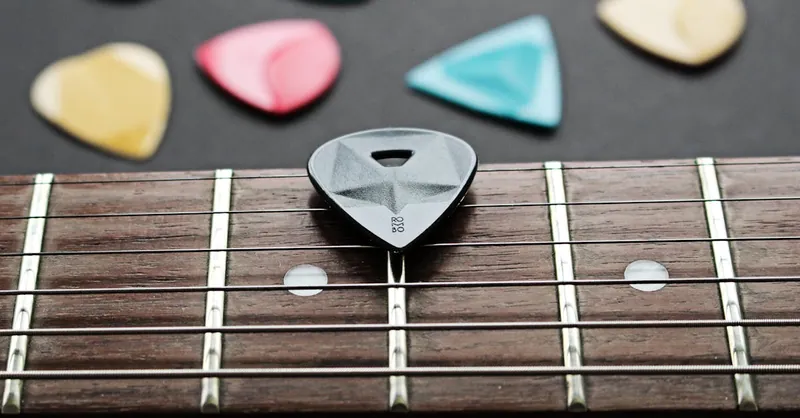
Image courtesy of ROMBO
The Connection Between Guitar and Piano Scales: How Patterns Translate Across Instruments for Better Theory Comprehension
Understanding scales on both guitar and piano reveals an extraordinary synergy that enhances your overall music theory knowledge and instrumental fluency. While the guitar’s fretboard and piano’s keyboard are physically different, the underlying scale patterns and interval relationships remain the same—this universality is a powerful advantage for beginners and multi-instrumentalists alike.
Visual and Conceptual Parallels Between Guitar and Piano Scales
- On piano, scales are laid out linearly with white and black keys representing whole and half steps, making intervals visually explicit and straightforward to identify.
- Guitar presents these intervals in shifted, repeating shapes across strings and frets, requiring pattern recognition and spatial mapping skills.
- By cross-referencing the piano keyboard’s linear scale patterns with the guitar's box shapes, learners gain a clearer understanding of how whole and half steps organize any scale, improving mental visualization.
This comparative approach:
- Reinforces the concept of scale degrees and their intervals, making it easier to transpose scales into different keys on both instruments.
- Helps guitarists internalize fretboard patterns by associating notes with the more intuitive layout of piano keys.
- Enables pianists to understand scale shapes in a spatial, modular way, similar to fretboard boxes, which can speed up learning guitar or other fretted instruments.
How Translating Scale Patterns Boosts Music Theory Mastery
When you learn to switch smoothly between piano and guitar scales, you develop a multi-dimensional grasp of music theory. This cross-instrument perspective allows you to:
- Recognize universal scale formulas (major, minor, pentatonic, modes) beyond a single instrument’s mechanics.
- Understand chord-scale relationships more deeply by visualizing how chords build up from scale notes on both fretboard and keyboard.
- Improve ear training and sight-reading skills by linking physical note locations to theoretical concepts in multiple contexts.
- Accelerate improvisation skill by applying familiar scale shapes in diverse performance settings, whether jamming on guitar or composing at the piano.
Ultimately, exploring scales across guitar and piano deepens your intuitive knowledge of music’s fundamental language. This holistic approach makes theory less abstract and more actionable—empowering you to play, create, and understand music with confidence on either instrument.
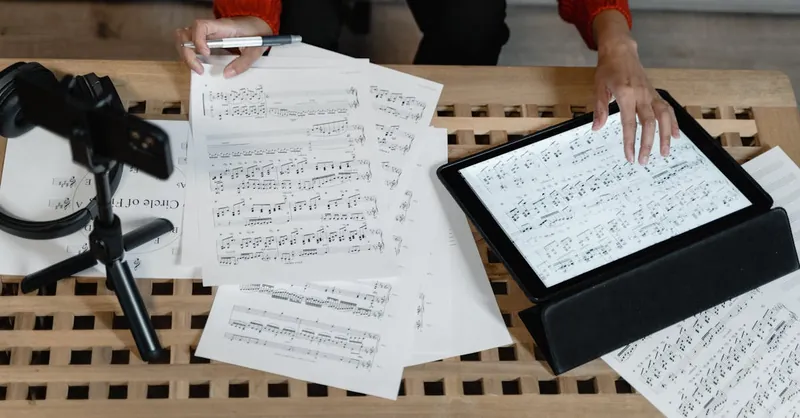
Image courtesy of Tima Miroshnichenko
Common Scale Modes and Their Emotional Colors: Introduction to Dorian, Phrygian, and Mixolydian on Guitar
Stepping beyond the familiar major and minor scales opens up an exciting world of musical modes—each with its own unique mood, color, and expressive potential. Modes are variations of the major scale, created by starting on different scale degrees while maintaining the same sequence of intervals. For guitarists, learning common modes like Dorian, Phrygian, and Mixolydian enriches improvisation, songwriting, and understanding of diverse genres from jazz and funk to flamenco and rock.
What Are Modes and Why Do They Matter?
Modes are essentially alternative “lenses” through which a scale’s notes can be heard, emphasizing different notes and intervals that shift the emotional character of the sound. For example, while the Ionian mode is identical to the major scale and sounds bright and happy, the Dorian mode introduces a subtly jazzy, soulful vibe by flattening the 3rd and 7th scale degrees compared to Ionian’s major feel.
Guitar players who grasp modal theory gain versatile tonal tools to:
- Explore fresh sonic landscapes beyond major/minor tonality
- Improvise over different chord progressions with targeted note choices
- Compose melodies that evoke specific moods or cultural styles
Quick Guide to Three Popular Guitar Modes
| Mode | Interval Structure (from root) | Emotional Color | Example Use on Guitar |
|---|---|---|---|
| Dorian | 1, 2, ♭3, 4, 5, 6, ♭7 | Smooth, soulful, jazzy, bluesy | Minor key solos, jazz, funk grooves |
| Phrygian | 1, ♭2, ♭3, 4, 5, ♭6, ♭7 | Dark, exotic, Spanish/Flamenco feel | Spanish flamenco, metal riffs |
| Mixolydian | 1, 2, 3, 4, 5, 6, ♭7 | Bright and bluesy with a dominant seventh | Blues, rock, country solos |
Playing Modes on Guitar: Simple Approach
To practice modes on guitar, start with a familiar major scale shape—for example, the C major scale on the 8th fret—and mentally shift the “root” note to correspond with each mode’s starting degree. For instance:
- Dorian mode: Begin from the second degree of the major scale (e.g., D in C major). Its formula is like a natural minor scale but with a raised 6th.
- Phrygian mode: Start on the third degree (e.g., E in C major), characterized by a flattened 2nd giving it a mysterious, Eastern vibe.
- Mixolydian mode: Begin on the fifth degree (e.g., G in C major), which sounds like a major scale with a flattened 7th, perfect for bluesy or rock licks.
By internalizing these shifts and experimenting with modal scales over chords, you gain access to a rich palette of emotional colors that make your guitar playing more expressive and original. Plus, these modal concepts translate directly to piano, reinforcing your overall music theory fluency across instruments.
Exploring modes not only enhances your improvisational vocabulary but also deepens your understanding of how scales form the emotional backbone of music—empowering you to connect more deeply with your instrument and the music you create.

Image courtesy of Keith Wako
Practical Exercises to Master Scales: Step-by-Step Practice Routines for Guitarists
Mastering guitar scales requires not just theoretical knowledge but consistent, focused practice. Building a solid routine with practical exercises will help embed scale patterns into your muscle memory, improve finger dexterity, and develop smooth picking techniques essential for fluid playing. Below are effective step-by-step routines tailored for beginners aiming to confidently navigate scales and apply them creatively.
Step 1: Start with Simple Scale Sequences
Instead of running straight up and down a scale, practice scale sequences—small groups of notes played in a pattern that develops your precision and timing. For example, play the major scale in groups of three or four notes, like this ascending 3-note sequence:
- Play notes 1, 2, 3; then 2, 3, 4; then 3, 4, 5; and so on.
This approach improves your finger independence and ear training, helping you hear how scale fragments combine musically.
Step 2: Incorporate Alternate Picking Technique
Using a consistent alternate picking (down-up-down-up) approach is crucial for clean, fast scale runs. Practice scales slowly at first, focusing on:
- Synchronizing your right-hand picking with left-hand fretting.
- Keeping strokes economical—move your pick just enough to hit the string cleanly.
- Maintaining relaxed hand tension to avoid fatigue.
Gradually increase speed using a metronome, ensuring accuracy is maintained. This builds the foundation for responsive, articulate playing across all scale types.
Step 3: Experiment with Creative Scale Licks
Once comfortable with patterns, start improvising creative licks by mixing scale notes with expressive guitar techniques such as:
- Hammer-ons and pull-offs to create fluid legato phrases
- Slides between notes for melodic movement
- String bends to add emotional tension and vocal-like phrasing
- Vibrato to sustain and color certain notes
Try playing these licks over backing tracks in the scale’s key to understand their musical context and improve your improvisation skills.
Step 4: Apply Scales Across the Fretboard and Keys
To internalize scales fully, practice moving your scale patterns horizontally and vertically along the fretboard, as well as transposing them to different keys. This exercise strengthens your fretboard visualization and flexibility, allowing you to adapt quickly in jams or songwriting sessions.
- Start by shifting the scale shape up or down a few frets to play in new keys.
- Connect scale patterns across adjacent positions to cover wider fretboard areas.
- Combine scale sequences with rhythm exercises to enhance timing and groove.
By regularly integrating these practical exercises into your practice routine, you’ll develop not only technical mastery but also a deeper creative connection with guitar scales. This hands-on approach solidifies music theory concepts, making scales a natural extension of your playing rather than a complicated chore. Whether you're soloing, composing, or jamming, these exercises ensure scales become powerful tools in your musical arsenal.

Image courtesy of Photo By: Kaboompics.com
Using Scales to Improvise and Compose: Applying Your Scale Knowledge in Songwriting, Soloing, and Jamming
Once you’ve gained a solid understanding of guitar scales and how they map across the fretboard, the true magic happens when you apply this knowledge creatively. Using scales for improvisation, composition, and jamming transforms theoretical concepts into expressive music, empowering you to craft original melodies, compelling solos, and engaging collaborations.
Improvisation: Speaking Freely Through Your Guitar
Improvisation is essentially musical conversation using scale tones as your vocabulary. When soloing, your scale knowledge guides your note choices, enabling you to play melodically and harmonically “in the moment.” To improvise effectively:
- Choose the appropriate scale for the chord progression or song key—major, minor, pentatonic, or modes can fit different moods.
- Focus on target notes, especially chord tones and scale roots, to create phrases that sound intentional and connected.
- Experiment with rhythmic variety and expressive techniques (bends, slides, vibrato) to add personality to your lines.
- Listen and respond thoughtfully, letting your playing complement the backing music or other musicians.
This approach builds confidence and creativity without relying solely on memorized licks, making your solos more unique and musically meaningful.
Composition: Crafting Melodies and Harmonies with Scales
Understanding scales equips you to compose melodies and chord progressions that naturally work together. When writing songs or instrumental pieces:
- Select scales that match the emotional tone you want—major scales for upbeat, happy moods; minor or modal scales for introspection or exotic colors.
- Develop motifs using scale fragments, which can be repeated and varied to create cohesion.
- Experiment with scale degrees to shape tension and release—raising or lowering certain notes can dramatically affect the mood (e.g., using the harmonic minor’s raised seventh for dramatic effect).
- Use your knowledge of scale patterns to construct chords and voicings that fit your melody, ensuring harmonic coherence.
This theory-to-practice connection makes composition intuitive, enabling you to translate musical ideas directly from your instrument.
Jamming: Collaborating and Exploring Scales Live
Jamming with other musicians is a dynamic way to apply scale knowledge in real-time:
- Identify the key and suitable scales quickly to ensure your playing fits the group’s sound.
- Use familiar scale shapes and modes as a foundation, then gradually incorporate chromatic passing notes or outside tones to add interest.
- Respond to musical cues and solos from bandmates, weaving your lines with theirs to create engaging dialogues.
- Practice call-and-response phrasing, echoing, and complementing others' ideas to develop interactive improvisation skills.
By applying scales fluidly in jam contexts, you enhance not only your fretboard skills but also your listening, timing, and musical intuition—skills essential for any well-rounded guitarist or pianist.
Mastering the use of scales in improvisation, composition, and jamming unlocks true musical freedom, turning theoretical knowledge into expressive artistry that resonates with both players and listeners alike.

Image courtesy of Anna Pou
Tips for Memorizing and Internalizing Scales: Effective Strategies for Lasting Musical Growth
Memorizing and internalizing guitar scales is essential for unlocking your instrument’s full potential and accelerating your musical growth. To retain scale shapes and sounds efficiently, it’s key to combine consistent practice methods with strategies that engage your aural and visual memory. Here are some proven tips to make scales stick in your mind and fingers, boosting your confidence and creativity over time.
1. Use Visualization and Pattern Recognition
Learning to visualize scale patterns on the fretboard rather than just memorizing note-by-note empowers you to navigate scales fluidly. Focus on the shape and intervals within each scale position, and train yourself to recognize familiar patterns wherever you are on the neck. Relate these shapes back to their intervallic formulas (whole steps, half steps) and root note placements to deepen your conceptual understanding. This also helps when shifting scales to different keys.
2. Incorporate Auditory Training: Hear the Scale
Internalizing the sound of each scale is just as crucial as memorizing finger patterns. Actively listen to recordings of scales, sing or hum the notes aloud, and play scales slowly while focusing on their tonal qualities. This approach links your ear with your muscle memory, enabling you to recognize and reproduce scales by ear during improvisation or composition.
3. Practice Scales in Context and with Variety
Avoid mechanical repeating of scales in linear runs. Instead, practice scales using:
- Sequences and melodic fragments (groups of 3-4 notes) to build musical phrasing.
- Improv exercises over backing tracks that force you to apply scales in harmonic contexts.
- Different rhythms and articulations, like staccato or legato, to keep your brain engaged.
Varying your practice routine prevents burnout and solidifies your grasp of scales in real musical settings.
4. Connect Scales Across the Fretboard and Instrument
Challenge yourself to link scale shapes horizontally and vertically, expanding your fretboard knowledge rather than staying confined to one position. Additionally, transfer your scale learning to the piano keyboard if you play or study that instrument too—this multiplatform approach cements universal music theory concepts and enhances your adaptability.
5. Regularly Review and Reinforce
Frequent, short practice sessions are more effective than sporadic, lengthy ones. Consistency and repetition reinforce both your visual and aural memory of scales, transforming them into intuitive tools you can summon effortlessly during playing and improvisation.
By implementing these strategies, you’ll move beyond rote memorization, internalizing scales as organic parts of your musical vocabulary that inspire creativity and lifelong growth on guitar and piano. This integrated approach makes scales both accessible and deeply musical, powering your journey from beginner to confident musician.

Image courtesy of Yan Krukau
